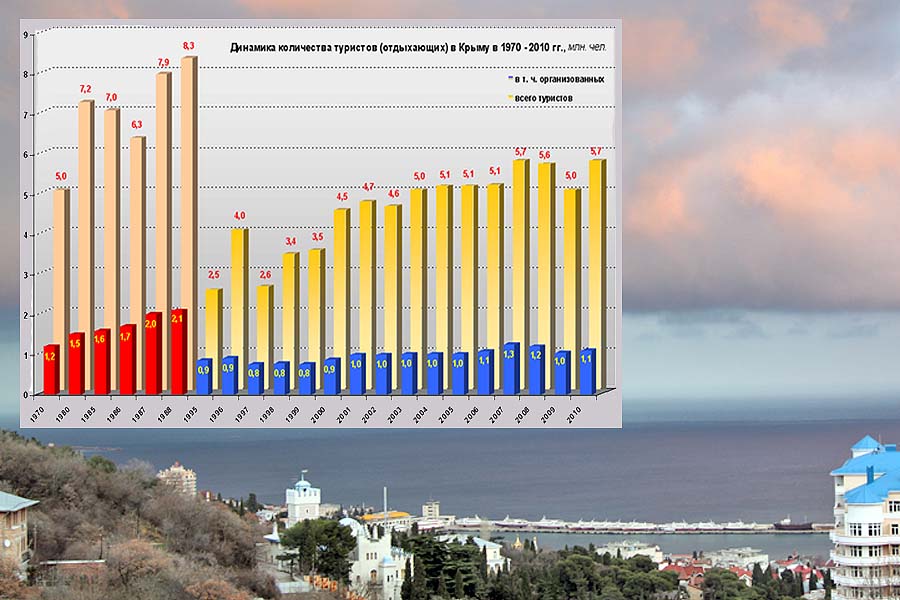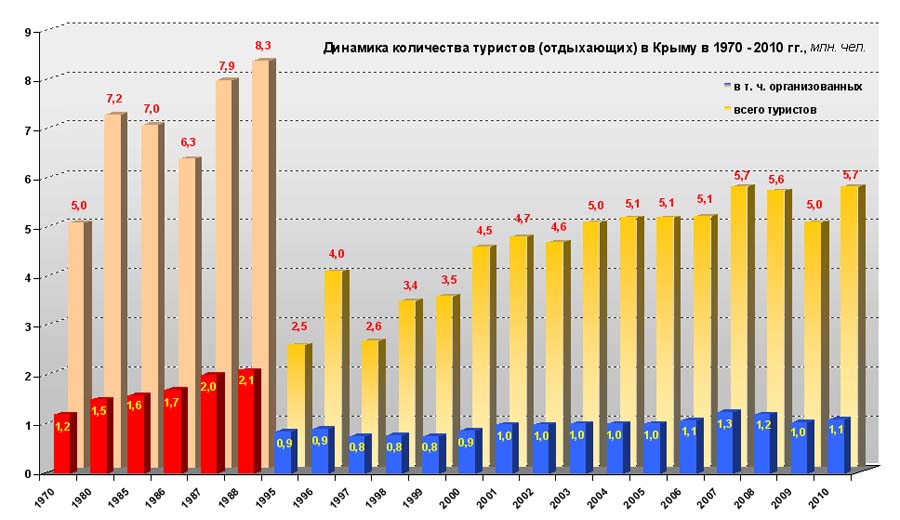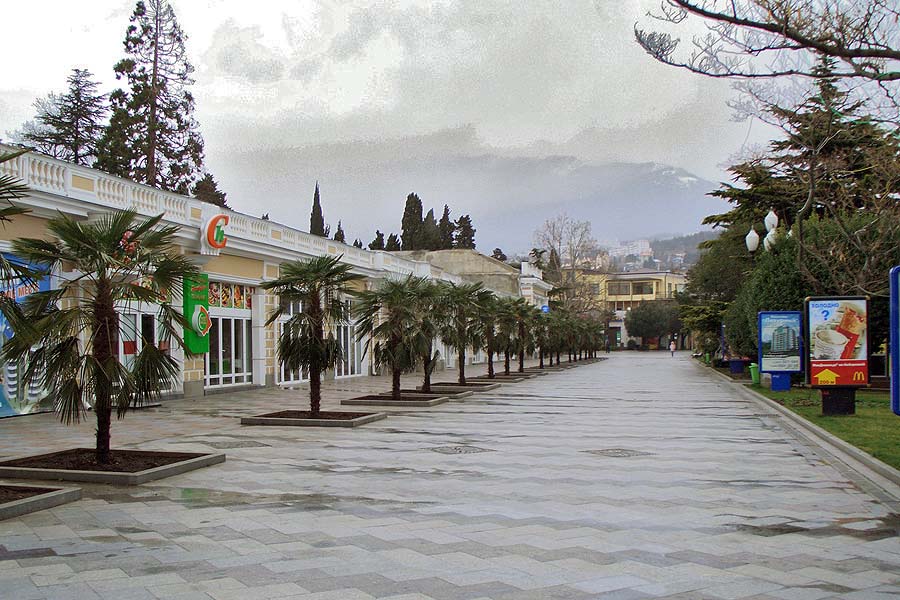Crimean economy without myths ... about tourism (4) Exclusive from BlackSeaNews

Dynamics of the number of tourists (holiday makers) in the Crimea in 1970 - 2010, mil. person.
Incl. organized tourists
Total number of tourists
Andrei KLIMENKO,
Chairman of Tavrichesky Institute of Regional Development,
Honored Economist of the AR Crimea,
Chief Editor of BlackSeaNews
Tatiana GUCHAKOVA,
Director of Tavrichesky Institute of Regional Development,
Leader of the BlackSeaNews Project
Continued from: Crimean economy without myths (1) Exclusive from BlackSeaNews
Crimean economy without myths (2) Exclusive from BlackSeaNews
Crimean economy without myths (3) Exclusive from BlackSeaNews
For nearly 130 years tourist perception of the Crimea has been the naively usual and naively natural contex of all the philistine concepts of its development... But six months ago, resorts and tourism have officially become number one priority of the new strategy of the Crimea ...
What are the risks and what the Crimean government can rely on? What will turn out of this? If will …
Crimean resorts: challenges and options
In late 2010, tourism and resorts for the first time in the history of the Crimea have officially become the number one priority of the new Crimean strategy.
Despite the quasi apparentness, this decision of the Council of Ministers and the Verkhovna Rada of the Crimea is in fact extremely important, responsible and challenging step in the activities of the authorities to meet the crying need of restructuring of the Crimean economy.
The complexity of such a choice involved the following.
1.Despite the naturally-occurring perception of the Crimea as the main tourist region of Ukraine, neither in the Soviet time, nor during more than 20 years of Ukraine's independence, tourism has ever been or is at the moment the main budget-forming sector of the economy of the peninsula.
During the period of growth - in 2001-2008 - the share of this industry (directly) in the formation of the consolidated budget revenues of the Crimea amounted 7-8%, and after the 2008 crisis, it shows a tendency for reduction to the 6% level.
According to the data of the StateTax Administration of the Autonomous Republic of the Crimea for the year of 2010 budget revenue to the budgets of all levels amounted 5 230.1 mln. (2009 - 4 247.6 mln.). Revenues from enterprises of resort industry (CTEA 85.11.3., 63.3, 55.2) in 2010 reached 320.6 mln. (6.12%), in 2009 - 270.7 million USD (6.37%).
2. Economic recovery after the 2008 crisis in the relatively developed, but turned into almost "mono-touristic" regions of the Crimea (Yalta, Alushta, Evpatoria) was slower than in the industrial and agricultural regions of the peninsula with the smaller share of tourism.
Thus, adoption of the decision on the paramount strategic priority of tourism for the Crimea coincided with the beginning of the unfavorable period for the Crimean and world tourism in general - the post-crisis decline of mass demand for entertainment and recreation of population, including in developed countries, and/or reduction of the spending for these items.
Dynamics of the revenue to the budgets of all levels
by the Crimean areas with resort-tourist sector of economy, thous., UAH
|
City, district |
2009 |
2010 |
2010/2009, % |
|
|
|||
|
Predominantly resort areas |
|||
|
Alushta |
147 948,9 |
168024,5 |
113,6 |
Yevpatoria
|
241045,9 |
264044,2 |
109,5 |
|
|
529914,4 |
627267,9 |
118,4 |
|
Relatively developed industrial-agrarian and resort areas |
|||
|
Sudak |
66829,7 |
83241,3 |
124,6 |
Feodosiya
|
269271,4 |
324782,6 |
120,6 |
Bakhchysarai district |
89604,3 |
115296,4 |
128,7 |
|
Simferopol district |
121173,8 |
193597,2 |
159,8 |
|
Agro-resort areas of the western and eastern Crimea |
|||
|
Saki (town + district) |
135765,0 |
156800,4 |
115,5 |
|
Chernomorsky district |
53952,4 |
63463,6 |
117,6 |
|
Razdolnensky district |
22596,8 |
25590,5 |
113,2 |
|
Leninsky district |
99113,2 |
105664,8 |
106,6 |
|
Industrial areas with a moderate resort share |
|||
|
Kerch |
251225,5 |
279323,1 |
111,2 |
|
Total |
2028441,1 |
2407096,5 |
118,7 |
3.By 2010, despite the growth of Ukraine's economy, especially in the 1st half of the 2000’s, the resort and tourism industry of the Crimea was not able to restore the volume of tourist flow, typical for the peninsula in 1980’s.
In terms of total number of tourists by the mid-2000s the Crimea has only reached the level of 1970’s (5-6 million of holiday makers, of which 1-1.2 million in health spa hotels still called locally “sanatoria”, and remains at the level significantly less than the maximum, reached in the middle of 1980’s (more than 8 million tourists, of which more than 2 million health spa hotels (sanatoria).
But it is not just the quantity only, but also the "bed-days" – there was such an amusing term in the time of the Soviet resorts, which corresponds to the term "nights", adopted in the world tourism – here everything becomes even more difficult (see paragraph 4.)

Dynamics of the number of tourists (holiday makers) in the Crimea in 1970 - 2010, mil. person.
Incl. organized tourists
Total number of tourists
4.The long period of stabilization of the number of tourists in the middle of the 2000's (after a quick, almost 2 times, recovery growth of 1998-2003) at the level of 5.0-5.5 million people (with 1-1.2 million tourists in health spas, hotels, pensionate holiday hotels) indicates that
by the time of adoption of decision to prioritize tourism in the Crimea in 2010, the "easy", lying on the surface, reserves of the industry have been exhausted - the flow of tourists reached the stable level, corresponding to the current state of the Crimean tourism and its infrastructure.
Dynamics of total number of tourists in the Crimea, mil. people.
|
|
1970 |
1980 |
1985 |
1986 |
1987 |
1988 |
1995 |
1996 |
1997 |
1998 |
1999 |
|
Total tourists |
5,0 |
7,2 |
7,0 |
6,3 |
7,9 |
8,3 |
2,5 |
4,0 |
2,6 |
3,4 |
3,5 |
|
incl, organized |
1,2 |
1,5 |
1,6 |
1,7 |
2,0 |
2,1 |
0,86 |
0,91 |
0,76 |
0,78 |
0,75 |
table continuation
|
|
2000 |
2001 |
2002 |
2003 |
2004 |
2005 |
2006 |
2007 |
2008 |
2009 |
2010 |
|
Total tourists |
4,5 |
4,7 |
4,6 |
5,0 |
5,1 |
5,1 |
5,13 |
5,73 |
5,64 |
5,0 |
5,72 |
|
incl, organized |
0,88 |
0,99 |
0,99 |
1,01 |
1,02 |
1,02 |
1,08 |
1,25 |
1,2 |
1,04 |
1,1 |
Moreover, the actual amount of the reduction of the tourist flow to the Crimea in comparison with historical maximum of mid-1980 is about 2 times more than reflected by figures of the number of tourists.
The case is that over the last 20 years the average duration of stay has reduced in the Crimea from 20-24 days to 10-14 days.
Accordingly, halving of number of holiday makers in health spa and resort establishments in comparison to the mid-1980s - from 2 million to 1 million people - means that the occupancy of health spa-resort industry regarding the number of tourist nights (bed-days) declined approximately 4 times.
4. In the 2000s, the process of transformation of the Crimea from a predominantly all–the-year-round into seasonal-summertime, mostly "beach" resort has almost completed.
The duration of the "high season" has shrunk from 4-5 months (May - September) to 1-1.5 months (July - August).

Yalta promenade in winter: an ordinary day ... Photo of Michael Rozenstein, BSN
Seasonality of the resort and the tourist flow, in turn, causes a similar seasonal processes in most sectors of the economy of the Crimea, in employment, in the fluctuations in level of the prices, the structure of incomes and consumer needs, in revenues to budget, in load on the social and engineering infrastructure.
The main competitors of the Crimea in the travel services market enjoy objectively better climatic conditions for beach holidays. Besides, almost all of them, unlike the Crimea, possess natural environment for winter (including skiing) holidays.
This implies that the profitability of the resort and tourism industry and the effectiveness of investment in this business in the Crimea can not be objectively compared with competitive countries as the length of the beach season in the Crimea is 2-2.5 months, while in some competitive countries it lasts up to 6-7 months of the year.
The formed seasonality of the Crimean resort made it risky, highly dependent on unpredictable weather and political factors, information warfare, low profitability, and therefore unattractive for large investments. Underinvestment, in its turn, exacerbate the situation more - in the sense of decrease of competitiveness and increase of stand behind the tourism industry of countries- competitors.
5.Underrun in the development of the Crimean tourism in comparison with competitive countries led in the 2000s to the loss by the Crimea of its most traditional tourist flows.
A significant number of the most effective tourist segment of cash people from regions of Ukraine and traditional for the Crimea Russian market shifted to resorts in Turkey, Egypt, the European Mediterranean.
Since the late1990s, Crimea became primarily an internal Ukrainian resort and the citizens of Ukraine with low-income make about 70-75% of the customers of the Crimean resort, about 22-25% are tourists from Russia and other CIS countries, about 3% - tourists from far non CIS countries ...
To be continued